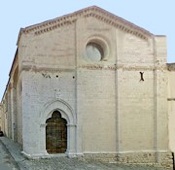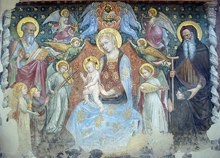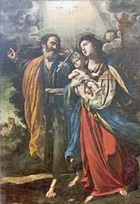


This church was first documented in 1292, when Pope Nicholas IV granted indulgences to those worshipping in it. It belonged to the monks of Santa Maria d’ Alfiolo outside Gubbio until 1439, when it passed to the friars of nearby Sant’ Agostino.
The Collegiata di Santa Cristina, which had been formed in 1639, was transferred to Santa Maria Nuova in 1725. It was transferred again in 1825 to Santa Maria dei Servi (which was reconsecrated at this time as Santa Maria Addolorata e Santa Cristina).
The church was deconsecrated in the early 20th century and used to store works of art from other churches. It can sometimes be visited, on application.
Exterior
The splendid portal in the otherwise austere façade is displaced to the left of centre.
Interior
The interior was remodelled in the 17th century, when it lost its fine vaulted ceiling. Many 14th century frescoes by local artists were also destroyed at this time but fortunately the celebrated Madonna del Belvedere by Ottaviano Nelli (see below) survives.
St Antony Abbot (14th century)
This fresco on the left wall is attributed to Mello da Gubbio.
Madonna del Belvedere (1408 or 1413)

This fresco, which is the masterpiece of Ottaviano Nelli, is encased in a sandstone tabernacle (1510) on the right wall. The inscription, which is now difficult to read, has been transcribed as:
OTTAVIAN(US) MARTIS EUGUBINUS PINXIT A.D.MCCCC(..)III
The missing letter in the date could be V or X, so the work probably dates to 1408 or 1413.
The fresco takes its name from the loggia under which the Madonna and Child are seated. These figures are surrounded by musical angels, and SS Emilianus (?) and Antony Abbot, who present the kneeling donors from the Pinoli family. Cherubs above crown the Madonna under the gaze of the Eternal Father.
Frescoes on the Counter-Facade (early 15th century)
Three frescoes on the counter-facade are attributed to Ottaviano Nelli and/or his workshop:
-
✴the Crucifixion, which is dated by a barely legible inscription to 1404 or 1407;
-
✴St Catherine of Alexandria; and
-
✴the Madonna del Latte, which depicts the Madonna and Child enthroned with SS James and Antony Abbot and a female martyr.
St Michael (ca. 1410)
This fresco on the counter-facade, which was rediscovered under plaster in ca. 1930, is attributed to Lorenzo Salimbeni. (Mauro Minardi, referenced on the page on the artist, supports this attribution and dating. However, he points out that other scholars believe that the fresco post-dates Lorenzo’s death in 1420 and therefore attribute it to his brother, Jacopo Salimbeni).
Altar Furniture from Sant’ Agostino
The gilded wooden tabernacle and altar screen were removed from the high altar of Sant’ Agostino and brought to Santa Maria Nuova in 1920.
Tabernacle (ca. 1577)
Bishop Mariano Savelli commissioned the gilding of this wooden tabernacle in 1577 and a will of 1583 provided for its ornamental housing (which suggests that it was finished by then). It is attributed to Faustino Maffei or (more recently) to Antonio Maffei. Altar Screen (1640-5)
Altar Screen (1640-5)
The Compagnia del SS Sacramento commissioned this screen in 1640 from Giovanni Francesco and Giacomo Casali, who were required to build it following a design by Michele Buti da Pisa. Giovanni Francesco subsequently withdrew from the contract, and Giacomo received payment for additional work on it in 1645. The structure contains a central niche that originally housed the tabernacle (above) and two smaller niches to the sides. These still contain their original statues, of St Augustine (on the left) and St William the Hermit.
[Check if the following altarpieces by/attributed to Francesco Allegrini are still in Santa Maria Nuova:
-
✴Madonna del Prato (ca. 1665)
-
✴St Mary Magdalene with SS Augustine and Cajetan (ca. 1672)]
Art from the Church
Frescoes (14th century)
These two detached frescoes were removed from Santa Maria Nuova in 1910 and are now in the Pinacoteca Civica. They depict:
-
✴the Madonna and Child enthroned;
-
✴the standing Madonna and Child; and
-
✴St John the Baptist.
Madonna and Child with saints (1619)
This altarpiece from the Collegiata di Santa Cristina, which is signed by Alessandro Brunelli, was moved: to Santa Maria Nuova in 1725; and to Santa Maria dei Servi in 1825. It depicts the Madonna and Child seated on a cloud with SS John the Baptist, Ubaldus, Francis and Charles Borromeo. The donor Giovanni Battista Cristini (who founded the Collegiata di Santa Cristina) is portrayed at the lower left.
Flight into Egypt (1634)

Sarcophagi
Two sarcophagi that previously contained the relics of St Ubaldus, [which were temporarily kept in Santa Maria Nuova] were moved [back] to Sant’ Ubaldo in 1997.
-
✴The sarcophagus (13th century) to the left of the apse was decorated with panels (early 14th century) that are attributed to the Maestro Espressionista di Santa Chiara (Palmerino di Guido?).
-
✴The relics were transferred to the sarcophagus (18th century) that now stands to the right of the apse in 1721.

